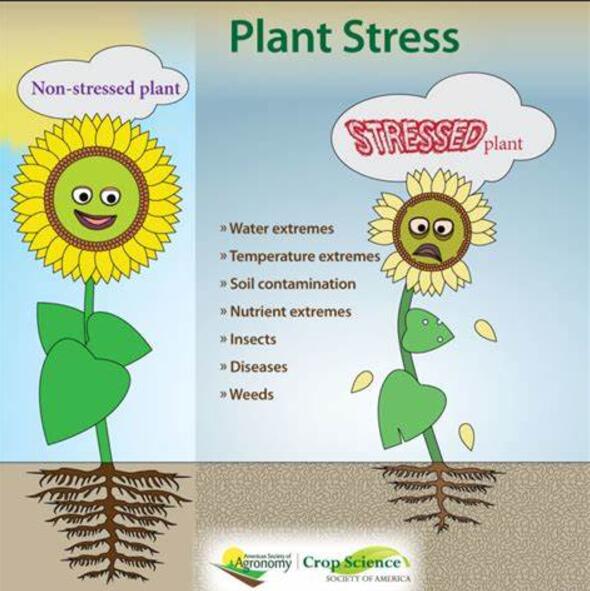解读作物基因型和丛枝菌根种类在磷胁迫下菌丝微生物组调节中的作用
IF 6.8
Q1 PLANT SCIENCES
引用次数: 0
摘要
在许多生态系统中,磷是一种限制性土壤养分,因为它与金属形成复杂的关系,导致植物养分胁迫。植物应对磷胁迫的策略之一是与丛枝菌根真菌(AMF)形成共生关系。虽然AMF以获取和运输磷的可接近形式而闻名,但它们的菌丝也支持多种细菌群落,其中一些细菌在有效溶解磷中起关键作用。尽管这种细菌伙伴关系可以提高AMF的共生效率,但影响各种植物基因型AMF组合中细菌选择的因素知之甚少。我们研究了来自不同目的AMF物种(根噬菌)(Rhizophagus intraradices, Gigaspora margarita),以及非AMF对照,以及三种具有不同根分泌物特征的不同高粱材料,如何影响根和菌丝微生物组。AMF菌丝中来自Chloroflexi、放线菌门和变形菌门的细菌较多,两种AMF菌丝间存在显著差异;然而,在所有AMF物种中,根显示出更丰富的变形菌。与根际土壤和对照土壤相比,根际土壤含有更多有机酸,如莽草酸和琥珀酸,以及糖,如蔗糖。此外,浅磷土壤富含甘露醇、木糖、n -乙酰氨基葡萄糖和3-羟基丁酸。总体而言,我们的研究结果表明,来自不同目的AMF物种,每个物种都有独特的生活史策略,明显影响菌丝细菌群落的多样性。本文章由计算机程序翻译,如有差异,请以英文原文为准。
Deciphering the role of crop genotypes and arbuscular mycorrhizal species in modulating hyphal microbiome under phosphorus stress
Phosphorus (P) is a limiting soil nutrient in many ecosystems due to complex formation with metals, leading to nutrient stress in plants. One of the strategies by which plants address P stress is by forming symbiosis with arbuscular mycorrhizal fungi (AMF). While AMF are known for acquiring and transporting accessible forms of P, their hyphae also support a diverse bacterial community, with some bacteria playing key roles in effective solubilization of P. Although this bacterial partnership could improve the symbiotic efficiency of AMF, the factors affecting the selection of bacteria across various plant genotype-AMF combinations are poorly understood. We investigated how different AMF species from various orders (Rhizophagus intraradices, Gigaspora margarita), alongside a non-AMF control, and three diverse sorghum accessions characterized by distinct root exudate profiles, impacted the root and hyphal microbiomes. The AMF hyphae had a higher prevalence of bacteria from Chloroflexi, Actinobacteria, and Proteobacteria, showing significant differences between the two AMF species; however, the roots displayed a greater abundance of Proteobacteria across all AMF species. Rhizosphere soils contained more organic acids, such as shikimic acid and succinic acid, as well as sugars such as sucrose, compared to hyphosphere and control soils. Additionally, hyphosphere soils were rich in mannitol, xylose, N-acetyl glucosamine, and 3-hydroxybutyric acid. Overall, our findings suggest that AMF species from different orders, each with unique life history strategies, distinctly influenced the diversity of hyphal bacterial communities.
求助全文
通过发布文献求助,成功后即可免费获取论文全文。
去求助
来源期刊

Plant Stress
PLANT SCIENCES-
CiteScore
5.20
自引率
8.00%
发文量
76
审稿时长
63 days
期刊介绍:
The journal Plant Stress deals with plant (or other photoautotrophs, such as algae, cyanobacteria and lichens) responses to abiotic and biotic stress factors that can result in limited growth and productivity. Such responses can be analyzed and described at a physiological, biochemical and molecular level. Experimental approaches/technologies aiming to improve growth and productivity with a potential for downstream validation under stress conditions will also be considered. Both fundamental and applied research manuscripts are welcome, provided that clear mechanistic hypotheses are made and descriptive approaches are avoided. In addition, high-quality review articles will also be considered, provided they follow a critical approach and stimulate thought for future research avenues.
Plant Stress welcomes high-quality manuscripts related (but not limited) to interactions between plants and:
Lack of water (drought) and excess (flooding),
Salinity stress,
Elevated temperature and/or low temperature (chilling and freezing),
Hypoxia and/or anoxia,
Mineral nutrient excess and/or deficiency,
Heavy metals and/or metalloids,
Plant priming (chemical, biological, physiological, nanomaterial, biostimulant) approaches for improved stress protection,
Viral, phytoplasma, bacterial and fungal plant-pathogen interactions.
The journal welcomes basic and applied research articles, as well as review articles and short communications. All submitted manuscripts will be subject to a thorough peer-reviewing process.
 求助内容:
求助内容: 应助结果提醒方式:
应助结果提醒方式:


